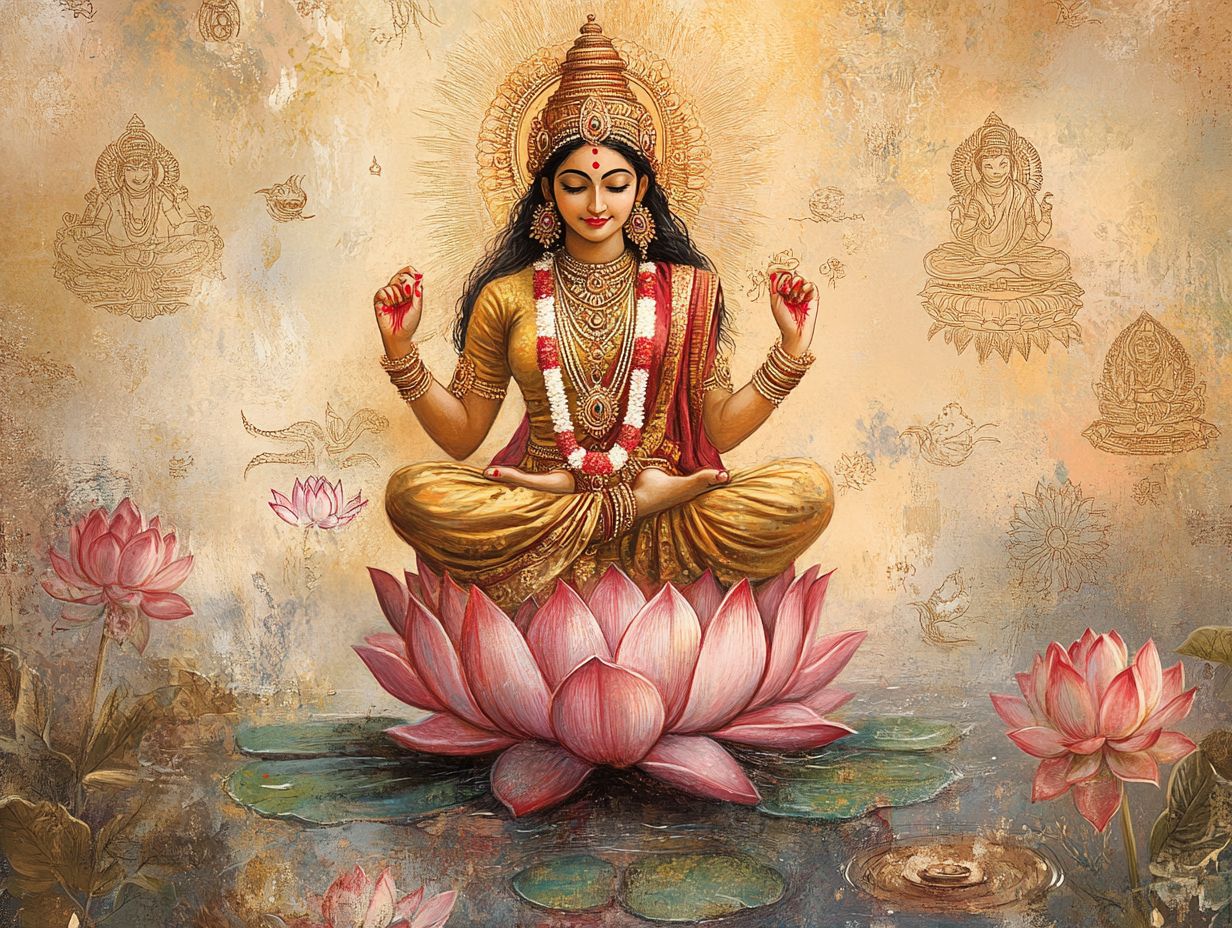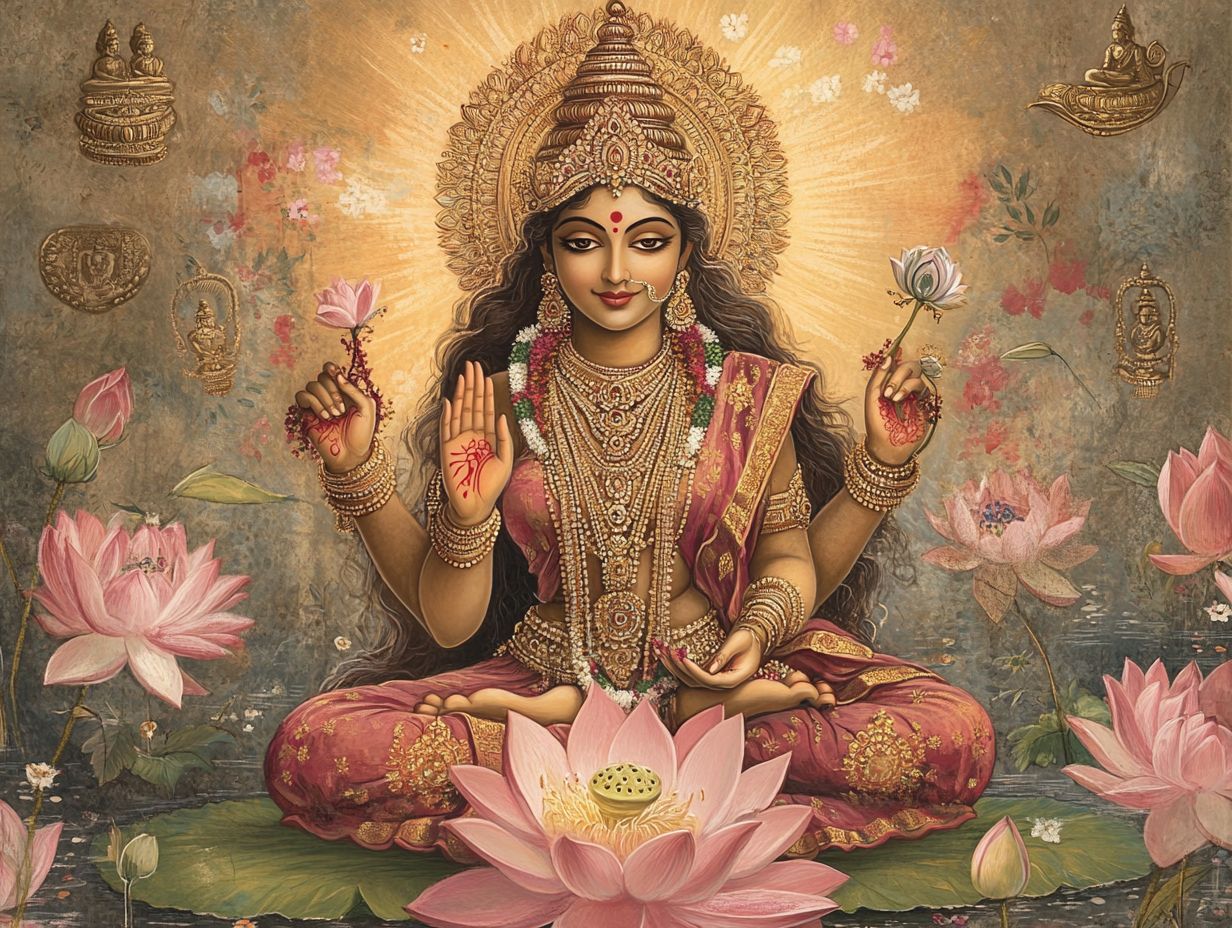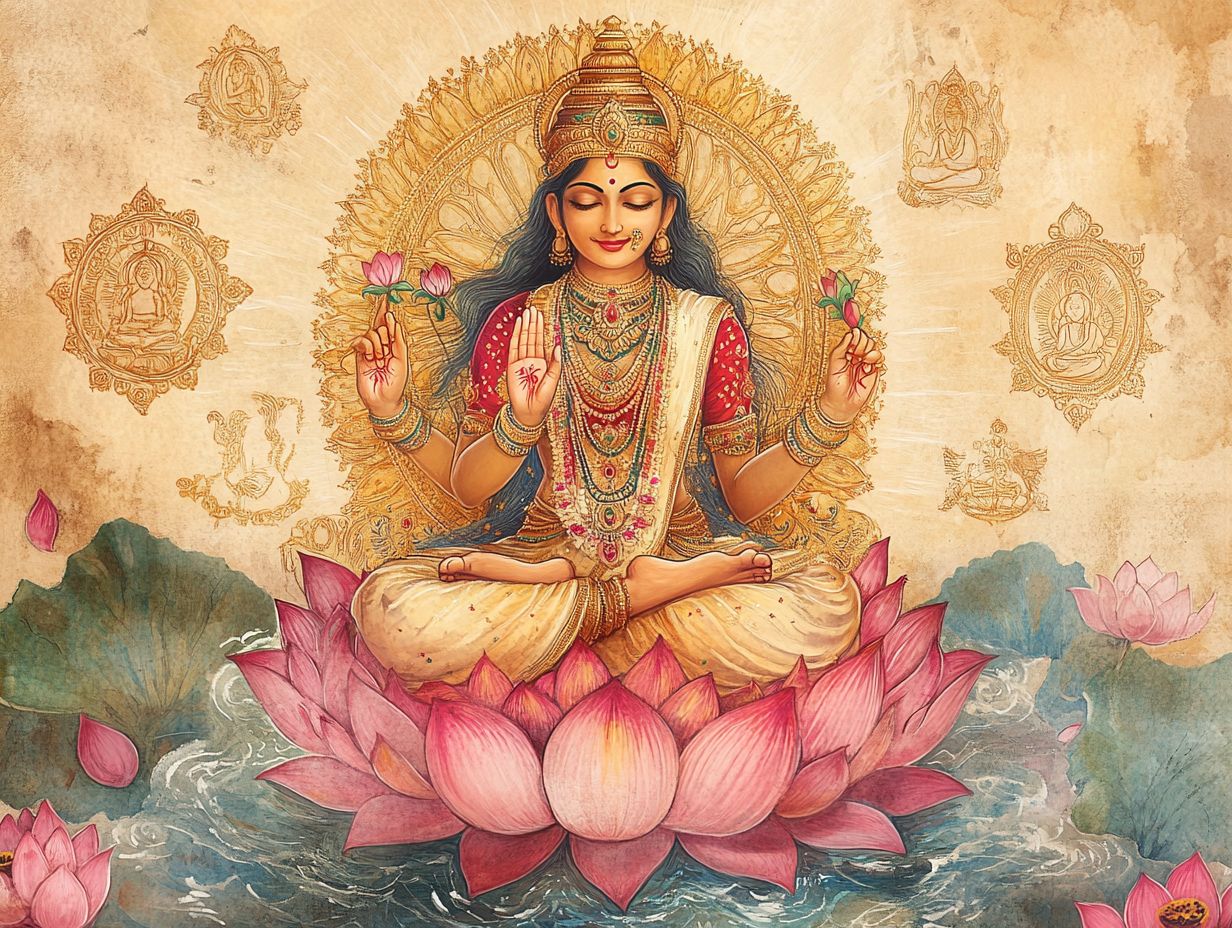Is Lakshmi Hinduism or Buddhism?
Lakshmi stands as a venerated figure in both Hinduism and Buddhism, embodying the ideals of prosperity, wealth, and abundance. This exploration delves into her origins, symbolism, and significance within these two major religions, highlighting her importance in Indian culture and spirituality.
The piece reveals the beliefs and practices that surround Lakshmi in Hinduism, shedding light on her various forms and representations. It also examines her connection to Buddhism, offering insights into how she is perceived within that tradition.
Furthermore, a comparison of the similarities and differences in her portrayal across both faiths will be undertaken, ultimately addressing the intriguing question: Is Lakshmi primarily a Hindu or Buddhist deity? This comparative religion approach will examine her role in both traditions, and how her symbolism and worship differ and intertwine.
Who is Lakshmi?

Lakshmi, venerated as the goddess of wealth and prosperity, occupies a central position in various religions, including Hinduism and Buddhism. In Hindu mythology, she is esteemed as the consort of Lord Vishnu, representing not only material wealth but also spiritual richness and enlightenment.
As a crucial element of spirituality, she embodies the divine feminine, and her worship is essential to countless rituals, festivals, and traditions practiced by millions. The admiration for Lakshmi transcends cultural boundaries, highlighting her importance in a multitude of spiritual paths and religious practices that honor abundance, compassion, and the sacred nature of the divine energy she represents.
What is the Origin of Lakshmi?
The origin of Lakshmi can be traced back to ancient Hindu scriptures, such as the Vedic texts and Puranas, where she is portrayed as emerging from the churning of the ocean of milk (Samudra Manthan), a pivotal event in Hindu mythology that involved the collaboration of various Devas and Asuras.
This mythological narrative not only highlights her divine beauty and grace but also emphasizes her significant role as the goddess of wealth, fortune, and prosperity. Vedic texts depict Lakshmi as a luminous figure, adorned in resplendent jewels, embodying both spiritual and material abundance.
Her emergence from the ocean’s depths symbolizes the essential relationship between cosmic order and prosperity, serving as a reminder to devotees of the delicate balance between divine intervention and human effort. As a vital consort to the preserver Vishnu, Lakshmi’s attributes reflect the values of righteousness and stability, reinforcing her importance among Hindu deities and establishing her as a beacon of hope and abundance for her followers. Her role also highlights the anthropomorphism in Hindu mythology, where divine qualities are attributed to deities, making them more relatable to human experiences.
What is the Symbolism of Lakshmi?
Lakshmi’s symbolism is richly layered and multifaceted, often portrayed with a lotus flower in her hands, representing purity and spiritual enlightenment, alongside coins that signify wealth and prosperity. This iconography is central to her depiction in various religious texts and artistic representations, emphasizing her role as a bringer of both material and spiritual abundance.
The lotus, rising gracefully from muddy waters, embodies the profound notion that beauty and spiritual awakening can emerge from chaos and struggle, inspiring her followers to pursue inner peace amid the trials of life. In tandem, the coins, typically cascading from her hands, symbolize not only material wealth but also the abundance of knowledge and good fortune.
This duality representing the harmonious balance between spiritual fulfillment and material success encapsulates the essence of Lakshmi, establishing her as a venerated figure within Hinduism.
Numerous devotees seek her blessings through various rituals and festivals like Diwali and Lakshmi Puja, underscoring her significance in cultural practices designed to attract both prosperity and spiritual growth. These practices often involve offerings and meditative practices that honor her divine attributes and seek to manifest desired outcomes in the lives of her followers.
Lakshmi in Hinduism
In Hinduism, Lakshmi stands as the quintessential embodiment of wealth, prosperity, and beauty, her veneration encapsulating a rich tapestry of beliefs, rituals, and practices that underscore her vital significance among the pantheon of Hindu deities. Her presence is integral to the spiritual practices and cultural identity of millions of worshippers.
Devotees partake in a variety of rituals, particularly during festivals like Diwali, fervently seeking her blessings to invite abundance and prosperity into their lives.
The principles associated with Lakshmi highlight the paramount importance of dharma (righteousness) and karma (action), establishing her as a guiding force that sustains her followers throughout their spiritual journeys. These principles are deeply rooted in the ethical and moral values promoted by her teachings, encouraging a life of righteousness and purposeful action.
What are the Beliefs and Practices of Lakshmi in Hinduism?
The beliefs surrounding Lakshmi in Hinduism emphasize her revered status as a goddess who bestows wealth, prosperity, and well-being upon her devotees. This veneration gives rise to various practices and rituals dedicated to her worship, particularly during significant festivals.
During Diwali, devotees engage in elaborate Lakshmi Puja, earnestly seeking her blessings for their homes and businesses. This sacred observance involves not only the meticulous cleaning and decorating of living spaces but also the performance of specific prayers and the offering of various symbols of prosperity, such as rice, sweets, and coins.
The essence of devotion during these rituals is paramount; it is widely believed that a sincere heart and a mindset filled with gratitude not only attract divine favor but also nurture spiritual growth. Followers often take the time to reflect on their values and intentions, appreciating the abundance in their lives and committing to share their prosperity, thus embodying the true spirit of Lakshmi s teachings.
What are the Different Forms of Lakshmi in Hinduism?

In Hinduism, Lakshmi manifests in numerous forms, known as avatars, each embodying distinct aspects of prosperity and abundance. This diversity underscores her multifaceted nature among the pantheon of Hindu deities. These avatars are celebrated in various sects and traditions, each highlighting unique aspects of her divine energy and contributions to human well-being.
These various avatars are venerated across different sects, reflecting the intricate tapestry of beliefs woven around her divine essence. For instance, within Vaishnavism, she is often portrayed as the consort of Vishnu, symbolizing spiritual wealth and nurturing love. In contrast, Shakti traditions present her as a fierce embodiment of creation and sustenance, showcasing her dynamic role in the universe.
From Dhanya Lakshmi, representing agricultural prosperity, to Vijaya Lakshmi, associated with victory and success, each form of Lakshmi resonates profoundly within the cultural psyche, underlining her essential significance in both material and spiritual domains. The unique attributes ascribed to these forms illuminate the rich diversity within Hindu beliefs, illustrating how followers engage with her through various lenses of worship and reverence. This diversity in her manifestations also reflects the broader cosmology and cultural practices in ancient India.
Lakshmi in Buddhism
Lakshmi’s role in Buddhism, while not as prominent as in Hinduism, signifies a connection to the ideals of abundance and prosperity.
In this context, she is occasionally associated with various spiritual entities that embody comparable attributes, reflecting a shared reverence for the qualities she represents. These associations highlight the interconnectedness of spiritual practices in Buddhism and the shared emphasis on prosperity, compassion, and enlightenment.
What is the Connection between Lakshmi and Buddhism?
The connection between Lakshmi and Buddhism is anchored in their mutual emphasis on spiritual abundance and the cultivation of wealth as a pathway to enlightenment. This connection is evident in the way her teachings are integrated into Buddhist meditative practices and ethical conduct, emphasizing the importance of generosity and mindfulness.
Within the Buddhist framework, Lakshmi is often viewed as an embodiment of generosity and the nurturing of prosperity, harmonizing with the broader philosophical teachings that advocate for mindfulness and ethical living. This relationship underscores the notion that wealth transcends mere materialism; it is also a spiritual resource intended to facilitate one’s journey toward enlightenment. Lakshmi’s symbolism extends to the belief that true abundance encompasses not only spiritual fulfillment but also the capacity to assist others, highlighting the interconnectedness of all beings.
In this context, Lakshmi serves as a poignant reminder that the pursuit of wealth, when guided by compassion and wisdom, can foster greater harmony and deepen one’s understanding of the impermanence of life.
How is Lakshmi Viewed in Buddhism?
In Buddhism, Lakshmi is revered as a figure who embodies compassion, serving as a poignant reminder of the importance of generosity and the ethical stewardship of wealth within spiritual practices.
Unlike her portrayal in Hinduism, where she is primarily associated with prosperity and material abundance, the Buddhist interpretation highlights her transformative role as a guiding influence toward altruism and inner fulfillment. In this framework, followers are encouraged to value not only material gains but also the profound spiritual growth that arises from sharing and judiciously utilizing one’s resources. This approach aligns with the broader spiritual philosophy of Buddhism, which emphasizes the impermanence of life (samsara) and the pursuit of nirvana through ethical living and meditation.
Lakshmi stands as a symbol of nurturing kindness, inspiring individuals to cultivate a mindset rooted in giving and compassion. By embracing her virtues, devotees are empowered to foster a sense of community and interconnectedness, elements that are essential for both personal and collective enlightenment. This resonates with the teachings of the Bhakti movement, where devotion and selfless service are paramount.
Comparison between Hinduism and Buddhism
An examination of Lakshmi within the contexts of Hinduism and Buddhism uncovers a fascinating interplay of similarities and differences in beliefs, practices, and the broader spiritual journeys that adherents of each tradition pursue. This cross-cultural analysis provides a deeper understanding of how her divine attributes and symbolism are interpreted within different religious frameworks, enhancing the dialogue between these rich spiritual traditions.
What are the Similarities between Lakshmi in Hinduism and Buddhism?

The parallels between Lakshmi in Hinduism and Buddhism reveal a shared reverence for her as a potent symbol of abundance, prosperity, and the ethical dimensions of wealth within both spiritual traditions. Her presence in both religions highlights the shared cultural significance and the universal appeal of her divine qualities, fostering a greater understanding of the interreligious dialogue that bridges Hindu and Buddhist philosophies.
Both faiths acknowledge her pivotal role in promoting ethical prosperity, underscoring the notion that true wealth transcends mere material accumulation to embrace virtue and generosity. Through a multitude of rituals and ceremonies, including Lakshmi Puja during Diwali, devotees invoke her blessings, reflecting a common belief in the importance of her presence during auspicious moments and other sacred festivals.
The veneration of Lakshmi encompasses not only a desire for material success but also serves as a poignant reminder of the responsibilities accompanying abundance. By honoring her, individuals reaffirm their dedication to utilizing wealth for the greater good, thereby enhancing the well-being of their families and communities, and adhering to the ethical principles cherished in both religions. This is reflective of the moral values and ethical conduct promoted in both Hinduism and Buddhism.
What are the Differences between Lakshmi in Hinduism and Buddhism?
The differences in the interpretations of Lakshmi between Hinduism and Buddhism become evident within their respective theological frameworks. Hinduism places significant emphasis on her role as a goddess of material wealth and prosperity consciousness, while Buddhism highlights her symbolic representation of ethical abundance and spiritual wealth.
In Hindu belief, Lakshmi is revered as the goddess of prosperity, personifying the material success and economic stability that devotees aspire to attain in their lives. This association with wealth resonates deeply with the Hindu concept of Dharma, wherein financial well-being is regarded as integral to fulfilling one’s duties and responsibilities. This is evident in the sacred narratives found in Vedic texts and Puranas.
In contrast, Buddhism redirects the focus toward Lakshmi as a symbol of spiritual wealth and enlightenment. This perspective underscores the understanding that true abundance arises from ethical living and the cultivation of virtues such as compassion and generosity. Buddhist teachings often emphasize meditation and other spiritual practices to achieve this state of spiritual richness.
These contrasting representations not only unveil the differing priorities between the two religions but also illuminate profound philosophical themes regarding the nature of wealth and the various paths to fulfillment. Moreover, the iconography of Lakshmi differs between Hinduism and Buddhism, reflecting their unique cultural practices and religious symbols.
Is Lakshmi Considered a Hindu or Buddhist Deity?
While Lakshmi is primarily revered as a Hindu deity, her interpretations and significance within Buddhism reveal a shared admiration for her attributes of abundance and moral wealth. This duality underscores the interconnectedness of these traditions and highlights the comparative religion perspectives in interpreting Lakshmi s divine qualities.
In the realm of Hinduism, she stands as the goddess of prosperity, fortune, and beauty, frequently depicted alongside Lord Vishnu. This iconography symbolizes the intricate balance between material success and spiritual fulfillment. Devotees seek her blessings not only for personal advancement but also for the well-being of their communities, reflecting her cultural significance in Indian culture.
In Buddhist teachings, Lakshmi’s influence is subtly woven into the fabric of the philosophy, embodying ideals of generosity and enlightenment. Within this framework, she transcends mere material wealth, representing the spiritual richness that arises from altruism and wise living. Her presence in Buddhist deities demonstrates the syncretism in religious beliefs and practices.
This duality of interpretation underscores her remarkable versatility and the interconnectedness of these profound traditions, illustrating how a singular figure can resonate deeply across diverse spiritual landscapes. The teachings and mythological stories in both traditions highlight her role in spiritual journeys and ethical prosperity.
Frequently Asked Questions
Is Lakshmi Hinduism or Buddhism?
Lakshmi is a goddess commonly worshipped in Hinduism, but she is also revered in Buddhism as a manifestation of Tara. Her presence in both religions exemplifies the shared values and interreligious dialogue that enriches the understanding of divine attributes.
Can both Hindus and Buddhists worship Lakshmi?

Yes, both Hindus and Buddhists can worship Lakshmi, but the practices and beliefs may differ between the two religions. These differences can be seen in the sect differences and cultural practices that characterize each tradition.
Is Lakshmi a Hindu deity or a Buddhist deity?
Lakshmi is primarily considered a Hindu deity, but she is also recognized and worshipped in Buddhism. Her worship reflects shared traditions and the historical context of religious development in ancient India.
Why is Lakshmi worshipped in both Hinduism and Buddhism?
Lakshmi represents wealth, prosperity, and abundance, which are valued in both Hinduism and Buddhism. She is also viewed as a compassionate and loving deity in both religions. Her representation in religious texts and sacred narratives highlights her significance in the spiritual path of her followers.
Are there any differences in the portrayal of Lakshmi in Hinduism and Buddhism?
While the core beliefs and values associated with Lakshmi are similar in both religions, there may be slight differences in her appearance and symbolism based on cultural influences and interpretations. These differences reflect the distinct spiritual practices and sectarianism within each tradition.
Can someone of any faith pray to Lakshmi for blessings?
Yes, Lakshmi is believed to be a universal deity and is open to receiving prayers and offerings from people of all faiths. Her role as a female divinity and embodiment of divine feminine energy makes her accessible and revered across diverse spiritual landscapes.
